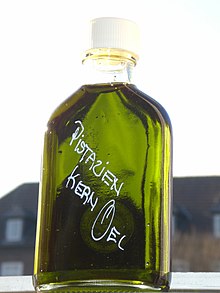
Pistachio oil is a pressed oil, extracted from the fruit of Pistacia vera, the pistachio nut.

Pistachio oil is a pressed oil, extracted from the fruit of Pistacia vera, the pistachio nut.
In all vegetable oils, the composition can vary depending on the cultivar, environmental conditions, harvesting, and processing. [1] [2]
The intense coloration, very characteristic of pistachio oil, is due to the content of chromophores, particularly chlorophyll and carotenoids. The total carotenoid content has been reported to be 15 - 61 mg/kg, with the main components in order of concentration being lutein, β-carotene, neoxanthin, luteoxanthin, and violaxanthin. The luteoxanthin content apparently increases, becoming the main species, in cold-pressed oils. The total chlorophyll content is much higher in pistachio oils extracted with solvents. The chlorophyll content is 128-200 mg/kg in solvent-extracted oils and 12-50 mg/kg in "virgin" oils, with the main components being chlorophyll a, chlorophyll b, pheophytin a, and pheophytin b. [3]
The high concentration of monounsaturated and polyunsaturated fatty acids makes it susceptible to auto-oxidation, which can be delayed by naturally present tocopherols or added antioxidants. The total sterol concentration detected in unrefined oils is 1840-4500 mg/kg. Other minor components of pistachio oil found in some studies include squalene, phenols with aldehydes, terpenes, and alcohols that give it a characteristic aromatic note. [4] [1] [5] [6]
Compared to other nut oils, pistachio oil has a particularly strong flavor. Like other nut oils, it tastes similar to the nut from which it is extracted. Pistachio oil is high in Vitamin E, containing 19mg/100g. It contains 12.7% saturated fats, 53.8% monounsaturated fats, 32.7% linoleic acid, and 0.8% omega-3 fatty acid. [7] Pistachio oil is used as a table oil to add flavor to foods such as steamed vegetables. [8]
Pistachio oil is also used in skin care products.

Olive oil is a liquid fat obtained by pressing whole olives, the fruit of Olea europaea, a traditional tree crop of the Mediterranean Basin, and extracting the oil.
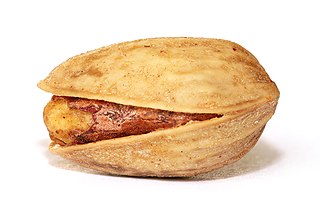
The pistachio, a member of the cashew family, is a small tree originating in Persia. The tree produces seeds that are widely consumed as food. The word can be countable or uncountable, meaning its plural is with or without an 's'.
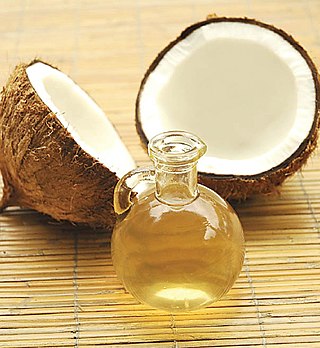
Coconut oil is an edible oil derived from the kernels, meat, and milk of the coconut palm fruit. Coconut oil is a white solid fat below around 25 °C (77 °F), and a clear thin liquid oil in warmer climates. Unrefined varieties have a distinct coconut aroma. Coconut oil is used as a food oil, and in industrial applications for cosmetics and detergent production. The oil is rich in medium-chain fatty acids.

Hemp oil is oil obtained by pressing hemp seeds. Cold pressed, unrefined hemp oil is dark to clear light green in color, with a nutty flavor. The darker the color, the grassier the flavour. It should not be confused with hash oil, a tetrahydrocannabinol-containing oil made from the Cannabis flower.

Oleic acid is a fatty acid that occurs naturally in various animal and vegetable fats and oils. It is an odorless, colorless oil, although commercial samples may be yellowish. In chemical terms, oleic acid is classified as a monounsaturated omega-9 fatty acid, abbreviated with a lipid number of 18:1 cis-9, and a main product of Δ9-desaturase. It has the formula CH3−(CH2)7−CH=CH−(CH2)7−COOH. The name derives from the Latin word oleum, which means oil. It is the most common fatty acid in nature. The salts and esters of oleic acid are called oleates. It is a common component of oils, and thus occurs in many types of food, as well as in soap.

Shea butter is a fat extracted from the nut of the African shea tree. It is ivory in color when raw and commonly dyed yellow with borututu root or palm oil. It is widely used in cosmetics as a moisturizer, salve or lotion. It is edible and is used in food preparation in some African countries. It is occasionally mixed with other oils as a substitute for cocoa butter, although the taste is noticeably different.
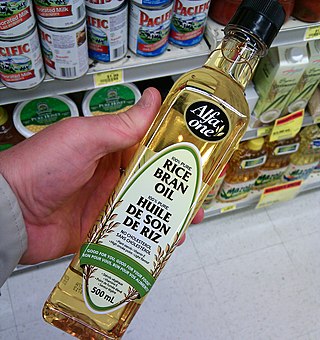
Rice bran oil is the oil extracted from the hard outer brown layer of rice called bran. It is known for its high smoke point of 232 °C (450 °F) and mild flavor, making it suitable for high-temperature cooking methods such as stir frying and deep frying. It is popular as a cooking oil in East Asia, the Indian subcontinent, and Southeast Asia including India, Nepal, Bangladesh, Indonesia, Japan, Southern China and Malaysia.
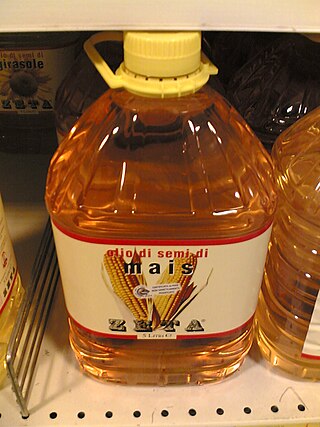
Corn oil or maize oil (British) is oil extracted from the germ of corn (maize). Its main use is in cooking, where its high smoke point makes refined corn oil a valuable frying oil. It is also a key ingredient in some margarines. Corn oil is generally less expensive than most other types of vegetable oils.
The smoke point, also referred to as the burning point, is the temperature at which an oil or fat begins to produce a continuous bluish smoke that becomes clearly visible, dependent upon specific and defined conditions. Smoke point values can vary greatly, depending on factors such as the volume of oil utilized, the size of the container, the presence of air currents, the type and source of light as well as the quality of the oil and its acidity content, otherwise known as free fatty acid (FFA) content. The more FFA an oil contains, the quicker it will break down and start smoking. The lower the value of FFA, the higher the smoke point. However, the FFA content typically represents less than 1% of the total oil and consequently renders smoke point a poor indicator of the capacity of a fat or oil to withstand heat.

Soybean oil is a vegetable oil extracted from the seeds of the soybean. It is one of the most widely consumed cooking oils and the second most consumed vegetable oil. As a drying oil, processed soybean oil is also used as a base for printing inks and oil paints.

Ferulic acid is a hydroxycinnamic acid; it is an organic compound with the formula (CH3O)HOC6H3CH=CHCO2H. The name is derived from the genus Ferula, referring to the giant fennel (Ferula communis). Classified as a phenolic phytochemical, ferulic acid is an amber colored solid. Esters of ferulic acid are found in plant cell walls, covalently bonded to hemicellulose such as arabinoxylans. Salts and esters derived from ferulic acid are called ferulates.
Carvacrol, or cymophenol, C6H3(CH3)(OH)C3H7, is a monoterpenoid phenol. It has a characteristic pungent, warm odor of oregano.

Sunflower oil is the non-volatile oil pressed from the seeds of the sunflower. Sunflower oil is commonly used in food as a frying oil, and in cosmetic formulations as an emollient.
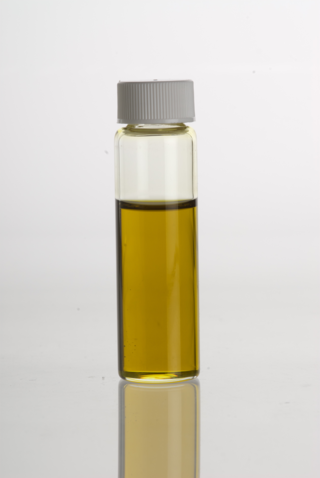
Avocado oil is an edible oil extracted from the pulp of avocados, the fruit of Persea americana. It is used as an edible oil both raw and for cooking, where it is noted for its high smoke point. It is also used for lubrication and in cosmetics.
Rose hip seed oil is a pressed seed oil, extracted from the seeds of the wild rose bush Rosa rubiginosa in the southern Andes. Rosehip seed oil can also be extracted from Rosa canina, a wild rose species native to Europe, northwest Africa, and western Asia. The fruits of the rosehip have been used in folk medicine for a long time. Rosehips have prophylactic and therapeutic actions against the common cold, infectious diseases, gastrointestinal disorders, urinary tract diseases, and inflammatory diseases.
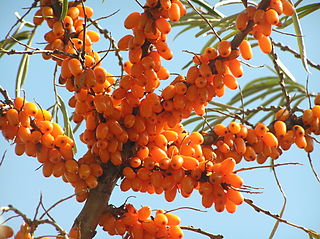
Sea buckthorn oil is a red-orange oil derived from sea buckthorn plants. The most commonly used species for this purpose is Hippophae rhamnoides. Species belonging to this genus accumulate lipids in the mesocarp, so the oil can be extracted from either the seeds or the pulp.

Methyl cinnamate is the methyl ester of cinnamic acid and is a white or transparent solid with a strong, aromatic odor. It is found naturally in a variety of plants, including in fruits, like strawberry, and some culinary spices, such as Sichuan pepper and some varieties of basil. Eucalyptus olida has the highest known concentrations of methyl cinnamate (98%) with a 2–6% fresh weight yield in the leaf and twigs.

Cooking oil is a plant or animal liquid fat used in frying, baking, and other types of cooking. Oil allows higher cooking temperatures than water, making cooking faster and more flavorful, while likewise distributing heat, reducing burning and uneven cooking. It sometimes imparts its own flavor. Cooking oil is also used in food preparation and flavoring not involving heat, such as salad dressings and bread dips.
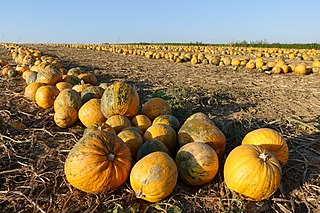
The Styrian oil pumpkin, also known as the Styrian pumpkin, is a variety of the common pumpkin which is cultivated to produce pumpkin seed oil.